In today’s fast-paced work environment, the ability to manage priorities effectively is a crucial skill that employers highly value. During job interviews, you’re likely to encounter questions about your priority management skills. This guide will help you navigate these questions with confidence and showcase your ability to handle multiple tasks efficiently.
Understanding Priority Management in the Workplace
Priority management is the process of organizing and executing tasks based on their importance and urgency. It’s a critical skill that demonstrates your ability to work efficiently, meet deadlines, and contribute effectively to your team’s goals.
 Priority management in the workplace
Priority management in the workplace
How Employers Assess Priority Management Skills
When asking about priority management, employers are looking to evaluate several key aspects:
- Time management abilities
- Decision-making skills
- Adaptability to changing circumstances
- Stress management under pressure
- Organizational skills
Understanding these evaluation criteria will help you frame your responses effectively during the interview.
Common Interview Questions and Sample Answers
Let’s explore some typical questions about managing priorities and how to answer them:
1. “How do you prioritize your work?”
Sample Answer: “I prioritize my work by first assessing the urgency and importance of each task. I use a matrix that categorizes tasks into four quadrants: urgent and important, important but not urgent, urgent but not important, and neither urgent nor important. This helps me focus on high-priority tasks first. Additionally, I regularly communicate with my team and supervisors to ensure my priorities align with the overall team and company goals.”
2. “Describe a situation where you had to juggle multiple important tasks. How did you handle it?”
Sample Answer: “In my previous role as a project manager, I once had to simultaneously manage the launch of a new product, prepare for a client presentation, and address an urgent issue with a supplier. I handled this by first quickly assessing which task had the most immediate impact on our business operations. I delegated some aspects of the product launch to my team members, focusing on critical decision points myself. I then addressed the supplier issue as it could potentially delay our operations. Lastly, I dedicated focused time to prepare for the client presentation. By breaking down each task, delegating where possible, and maintaining clear communication with all stakeholders, I successfully managed all three priorities within their respective deadlines.”
3. “How do you handle unexpected tasks or emergencies that disrupt your planned schedule?”
Sample Answer: “When unexpected tasks arise, I first quickly evaluate their urgency and importance relative to my existing priorities. If the new task is truly urgent, I reassess my current to-do list and look for tasks that can be briefly postponed or delegated. I communicate with my team or supervisor about the change in priorities to ensure everyone is aligned. I also try to build some flexibility into my daily schedule to accommodate unexpected issues without completely derailing my planned tasks.”
Tips for Answering Priority Management Questions
- Use the STAR method (Situation, Task, Action, Result) to structure your answers.
- Provide specific examples from your past experiences.
- Emphasize your decision-making process and rationale.
- Highlight your ability to adapt to changing circumstances.
- Mention any tools or techniques you use for priority management (e.g., to-do lists, project management software).
 Priority management tools and techniques
Priority management tools and techniques
Common Mistakes to Avoid
When answering questions about managing priorities, avoid these pitfalls:
- Being too vague or general in your responses
- Failing to provide concrete examples
- Indicating that you never face challenges with prioritization
- Suggesting that you routinely work overtime to complete tasks
- Neglecting to mention how you communicate changes in priorities to others
Follow-up Questions and How to Answer Them
Be prepared for these potential follow-up questions:
-
“How do you determine which tasks are most important?”
Suggestion: Explain your criteria for importance, such as impact on company goals, urgency, or stakeholder needs. -
“What do you do when you can’t meet all your deadlines?”
Suggestion: Discuss how you communicate with stakeholders, negotiate new deadlines, or seek additional resources. -
“How do you balance long-term projects with daily tasks?”
Suggestion: Describe your strategy for allocating time to both immediate needs and ongoing projects. -
“Can you give an example of a time when you had to reprioritize your workload quickly?”
Suggestion: Share a specific instance, focusing on your decision-making process and the outcome. -
“How do you handle conflicting priorities from different supervisors?”
Suggestion: Explain your approach to communication and negotiation in such situations.
For more insights on handling interview questions, check out our guides on how to answer questions about problem-solving and how to answer questions about time management.
Conclusion
Effectively answering questions about managing priorities can significantly boost your chances of success in a job interview. By understanding what employers are looking for, preparing specific examples, and avoiding common pitfalls, you can demonstrate your ability to handle multiple responsibilities efficiently. Remember to practice your responses and tailor them to the specific role and company you’re interviewing for. With these strategies, you’ll be well-equipped to showcase your priority management skills and impress your potential employers.
For more interview preparation tips, don’t forget to explore our article on how to answer situational interview questions. Good luck with your interview!




